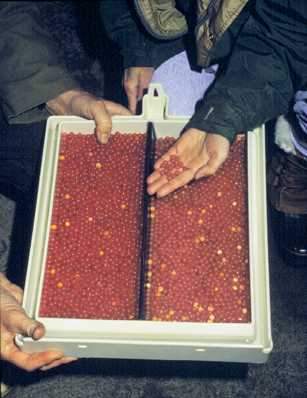Hatchery programs are strictly managed to produce healthy fish
from select breeding stock. Hatchery fish supplement native
stocks of salmon and steelhead and compensate for the small
percentage of juvenile fish that are killed during their
passage past hydro projects. According to the Mid-Columbia
Habitat Conservation Plan, hatchery fish can be used to
compensate for no more than 7 percent fish mortality. Safe
passage of young fish at the dams remains a primary goal.
The Rock Island Fish Hatchery Complex is made up of the central
hatchery and five satellites on the Wenatchee, Chiwawa, Methow
and Similkameen rivers and at Lake Wenatchee. Hatchery stocks
come from adult fish captured each year in target rivers. Eggs
from these fish are incubated in the hatcheries and then
juvenile fish are reared, acclimated, and released in the same
body of water the parent fish came from.
The central hatchery uses up to 23,000 gallons per minute of
cool well water in uncrowded conditions to maintain a
disease-free environment. Incubation water is chilled to 38
degrees to slow the egg development in much the same way that
cold winter weather affects naturally deposited eggs. The
result is the production of some of the healthiest hatchery
fish in the Pacific Northwest.
Each year spring and summer Chinook salmon, sockeye salmon and
steelhead are released from the hatchery system.
Monitoring
We place extreme importance on monitoring our hatchery program.
We are not only interested in whether the fish are healthy
leaving our hatchery facilities, but also, what affect they may
have on naturally produced fish. Our programs are designed to
increase natural production, so we monitor this and manage the
program adaptively (based on the information we gather).

Fish eggs for hatchery programs come from hatchery fish
captured each year in target rivers.